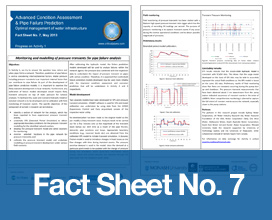Monitoring and modelling of pressure transients for pipe failure analysis
Objectives
In Activity 1, we try to answer the question how, where and when pipes fail in a network. Therefore, prediction of pipe failure is central considering internal/external factors. Water pressure including pressure transients is an important internal factor that can contribute to pipe failure. As part of the development of pipe failure prediction models, it is important to examine the likely transient development in local networks. Furthermore, any calibration of failure models developed would require likely transient pressures on top of static pressure for rational analyses. To facilitate this, static and transient hydraulic model of selected network is to be developed and be calibrated with field monitoring of transient events. The specific objectives of this component of Activity 1 research can be listed as:
identify a section of network for the analysis, which has been reported to have experienced pressure transient events;
undertake EPS (Extended Period Simulation) to obtain appropriate boundary conditions for the pressure transient modelling for the identified network section;
develop the pressure transient model and select locations for monitoring;
monitor selected locations in the pipe network for pressure transients; and
calibrate the pressure transient model and undertake modelling of pressure transient development under various field scenarios.

